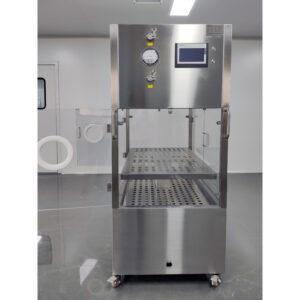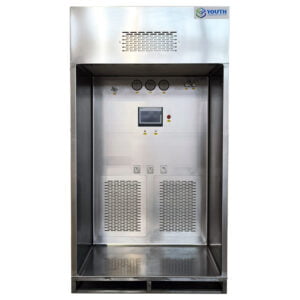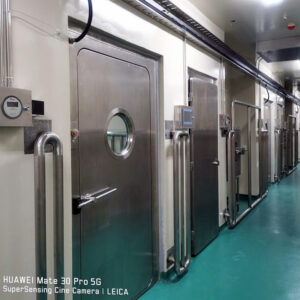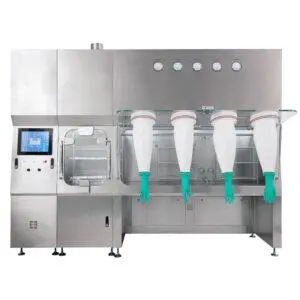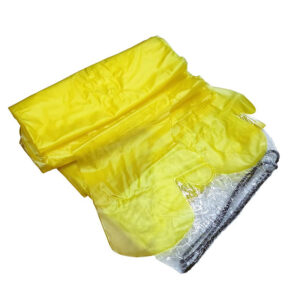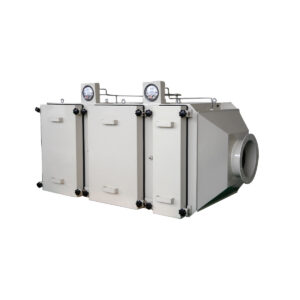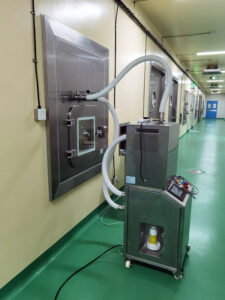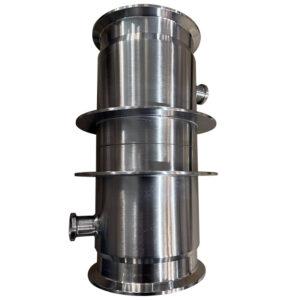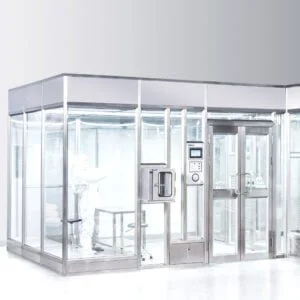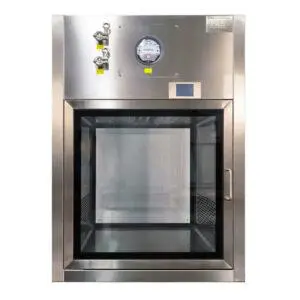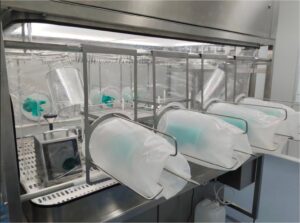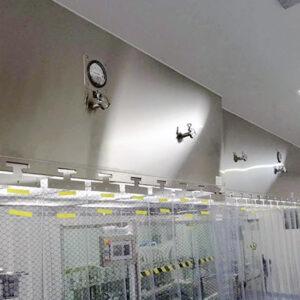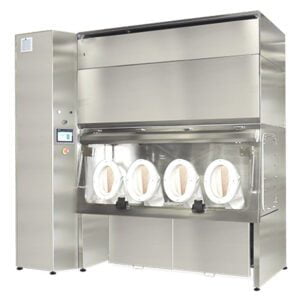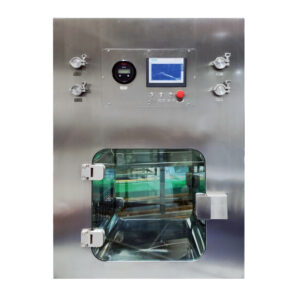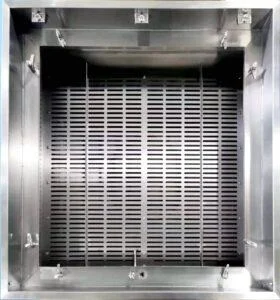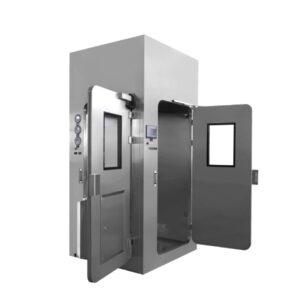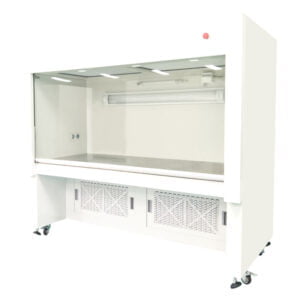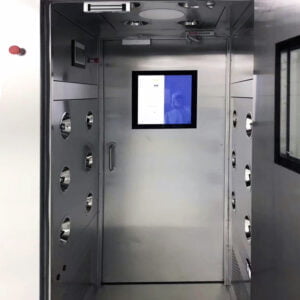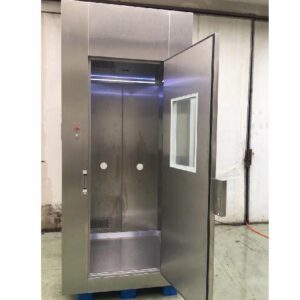Cross-contamination during material transfer remains the primary compliance failure point in pharmaceutical and semiconductor cleanroom operations. Despite advances in cleanroom design, many facilities still struggle with maintaining pressure differentials and particulate control when materials move between classification zones. The challenge intensifies when balancing operational efficiency with regulatory requirements across EU-GMP, WHO-GMP, and ISO 14644-1 frameworks.
Pass boxes serve as mandatory contamination control devices in GMP pharmaceutical factories, yet selection errors cost facilities an average of 18-24 months in validation delays. The decision between static, dynamic, semi-active, and active configurations directly impacts your compliance posture, operational workflow, and long-term maintenance burden. This guide provides the technical framework for pass box selection, integration, validation, and lifecycle management based on current 2025 regulatory requirements.
Understanding Pass Box Fundamentals: Types, Classifications, and Operational Principles
Core Function and Contamination Control Mechanism
Pass boxes are wall or floor-mounted transfer chambers designed to move materials between areas with different cleanliness classifications without disrupting airflow patterns or pressure cascades. The double-door configuration with interlock systems prevents simultaneous opening, maintaining the pressure differential barrier that keeps unfiltered air from migrating into controlled zones. This physical barrier approach addresses the fundamental problem: every direct door opening between cleanroom zones introduces turbulence and bidirectional airflow that can carry thousands of particles per cubic meter into critical areas.
The interlock mechanism—either mechanical or electronic—forms the primary defense against operator error. Mechanical interlocks use physical blocking plates that engage when one door opens. Electronic systems employ magnetic sensors and relay circuits that disable door actuators when the opposite door is unsealed.
Classification Framework and Selection Criteria
Static pass boxes provide a sealed transfer chamber without active airflow management. You’ll specify these when transferring materials between zones of similar classification—ISO Class 7 to ISO Class 7, for example—where the risk differential doesn’t justify active contamination control. The absence of fans and filters reduces maintenance requirements and eliminates noise in production areas.
Dynamic pass boxes incorporate built-in fans and HEPA filtration systems that continuously recirculate and purify chamber air. These units handle transfers from uncontrolled or lower-classified environments into controlled zones. I’ve observed that facilities often underestimate the validation burden dynamic systems introduce, particularly the quarterly differential pressure monitoring and annual HEPA integrity testing required under PIC/S guidelines.
Semi-active configurations connect to your facility’s existing HVAC system rather than using dedicated fan units. The chamber receives filtered air from the cleanroom’s supply plenum, creating positive pressure relative to the lower-classified side. This approach reduces capital costs but creates dependencies on your central air handling system’s performance and complicates troubleshooting during pressure deviation events.
Active pass boxes feature stand-alone fan and HEPA filter assemblies that operate independently of facility HVAC systems. You gain operational flexibility and simplified validation protocols, but at higher equipment costs and increased electrical infrastructure requirements.
Material Construction and Chemical Compatibility
Pass box chambers typically use 304 or 316 stainless steel. The 316 grade provides superior resistance to chloride-based disinfectants commonly used in pharmaceutical manufacturing. Welded construction with formed radius corners eliminates crevices where bacteria and particles accumulate—critical for facilities performing terminal sterilization or operating under aseptic processing requirements.
Surface finish specifications matter more than many engineers realize. A 2B mill finish (the standard cold-rolled finish) meets most applications, but electropolished surfaces reduce particle adhesion by 40-60% in comparative testing. Facilities producing sterile injectables should specify electropolished interiors with Ra values below 0.5 micrometers.
Pass Box Core Specifications and Standards
| Component | Specification | Regulatory Requirement |
|---|---|---|
| Construction Material | 304/316 Stainless Steel | EU-GMP Annex 1 |
| Door Interlock System | Mechanical or Electronic | EU-GMP, WHO-GMP |
| UV-C Disinfection | Optional 254nm wavelength | ISO 14644 compatible |
| HEPA Filtration | H14 grade, 99.97% @ 0.3μm | ISO 14644-1 |
| Pressure Monitoring | Differential pressure gauge | WHO-GMP recommended |
Source: EU GMP Guide Part 1, ISO 14644-1:2015
Selecting the Right Pass Box: A Technical Comparison of Materials, Interlocks, and Transfer Mechanisms
Airflow Management Systems and Filter Integration
Dynamic pass box configurations incorporate pre-filters and H14 HEPA filters removing 99.97% of particles at 0.3 microns—the most penetrating particle size. The recirculating airflow system typically operates at 0.36-0.54 m/s face velocity, creating laminar flow conditions during the transfer cycle. This continuous air purification reduces the particle count rebound that occurs after material placement in the chamber.
The filter housing design determines maintenance accessibility and replacement costs. Side-access filter chambers allow technicians to change filters without entering either cleanroom zone, reducing gowning requirements and downtime. Top-loading configurations save wall space but complicate filter replacement in facilities with suspended ceiling systems or dense overhead utilities.
DOP and PAO test ports provide access for aerosol challenge testing during validation and annual requalification. Position these ports upstream and downstream of the HEPA filter to enable in-situ leak testing without filter removal. Facilities lacking these ports face significantly higher validation costs due to filter removal and reinstallation requirements.
Interlock System Architecture and Failure Mode Considerations
Electronic interlock systems offer remote monitoring capabilities and integration with building management systems. You can log door opening events, track transfer cycle times, and receive alerts when doors remain open beyond programmed intervals. This data becomes valuable during contamination investigations and process deviation analysis.
Mechanical interlocks provide fail-safe operation during power outages—a critical consideration for facilities in regions with unstable electrical infrastructure. The mechanical blocking mechanism physically prevents simultaneous door opening without requiring electrical power. However, you sacrifice remote monitoring capabilities and must implement manual logbook systems to track transfer events.
I prefer electronic interlocks with mechanical backup systems for critical applications. This hybrid approach provides BMS integration during normal operations while maintaining door security during power failures.
Pass Box Type Technical Comparison
| Pass Box Type | Airflow System | Filtration Capability | Typical Application |
|---|---|---|---|
| Static | None (sealed barrier) | No active filtration | Similar classification zones |
| Semi-Active | Facility HVAC-dependent | External HEPA supply | Intermediate control zones |
| Dynamic | Built-in recirculating fan | Integrated H14 HEPA + pre-filter | Lower to higher classification transfer |
| Active | Stand-alone fan unit | Independent HEPA filtration | Critical areas, aseptic zones |
Note: Dynamic and active pass boxes include DOP/PAO test ports for filter validation.
Source: ISO 14644-1:2015, PIC/S
Optional Feature Evaluation and Cost-Benefit Analysis
UV-C disinfection systems operating at 254nm wavelength provide surface decontamination between transfer cycles. The typical exposure time ranges from 15-30 minutes depending on UV lamp intensity and target organism. While UV-C reduces surface bioburden, it doesn’t replace proper cleaning protocols and provides no protection against particles or chemical residues.
Differential pressure gauges mounted on the chamber exterior enable operators to verify airflow system performance before each transfer. The gauge should display pressure differential relative to the lower-classified adjacent space, with typical values ranging from 5-15 Pascals for dynamic systems. Analog magnehelic gauges cost less but require annual calibration; digital gauges provide datalogging capabilities but increase equipment costs by 30-40%.
Transparent door panels—tempered glass or polycarbonate—allow visual inspection of chamber contents without opening doors. This seemingly minor feature significantly reduces contamination risk in high-throughput operations where operators frequently verify transfer completion. Specify polycarbonate for environments using aggressive disinfectants that etch or yellow glass over time.
Integrating Pass Boxes into Your GMP and ISO 14644 Compliance Framework
Documentation Architecture for Validation and Regulatory Audits
Your validation package must include Certificates of Quality verifying material grades, mill test reports for stainless steel components, and dimensional inspection records confirming fabrication tolerances. Certificate of Origin documentation becomes mandatory when exporting equipment or operating in jurisdictions with local content requirements. Technical drawings should detail all wetted surfaces, filter specifications, electrical schematics, and interlock logic diagrams.
User manuals and SOPs form the operational foundation for compliance. The SOP must specify cleaning frequencies, approved disinfectants, transfer procedures, and response protocols for interlock failures or pressure deviations. I’ve seen facilities fail pre-approval inspections solely due to inadequate SOP documentation, despite having properly functioning equipment.
GMP Compliance Documentation Requirements Matrix
| Document Type | Content Requirement | Standard Reference |
|---|---|---|
| Certificate of Quality (CQ) | Material certification, test results | EU-GMP, PIC/S |
| Technical Drawings | Dimensional specs, construction details | ISO 14644 framework |
| User Manual & SOPs | Operation, cleaning, maintenance protocols | EU-GMP Annex 1 |
| IQ/OQ Protocols | Installation and operational qualification | EU-GMP, WHO-GMP |
| Factory Test Reports | Pre-delivery performance verification | PIC/S requirements |
Source: EU GMP Guide Part 1, PIC/S
Installation Qualification Protocol Development
IQ documentation verifies that equipment arrives as specified and installs correctly in the designated location. Your protocol should include dimensional verification confirming chamber sizing, material inspection verifying stainless steel grade (portable XRF analyzers provide non-destructive verification), and utility connection verification for electrical supply, HVAC integration points, and pressure monitoring systems.
Photographic documentation provides objective evidence of installation conditions. Capture images showing wall penetration sealing methods, gasket installation, mounting hardware torque verification, and clearance measurements around the unit. These images become invaluable during dispute resolution and provide visual reference for future modification projects.
Operational Qualification and Performance Verification
OQ testing demonstrates that pass box systems function according to design specifications under operating conditions. For dynamic units, this includes HEPA filter leak testing using DOP or PAO aerosols, airflow velocity measurements across the filter face, differential pressure verification, and interlock function testing under all door position combinations.
The interlock test protocol must verify that both doors cannot open simultaneously under any circumstances, including during power loss scenarios, BMS communication failures, and operator override attempts. Test each door’s closure verification sensor by attempting to open the opposite door with tape blocking the sensor—proper interlock design prevents opening even when sensors are defeated.
Environmental monitoring during OQ establishes baseline performance data. Conduct particle count measurements with the chamber empty, during simulated material transfer events, and during worst-case scenarios (maximum material load, multiple transfer cycles without rest periods). This data establishes your normal operating range for ongoing performance monitoring.
Strategic Placement and Installation for Optimal Cleanroom Material Flow
Contamination Risk Assessment and Pass Box Location Strategy
Pass box placement directly impacts contamination control effectiveness and operational efficiency. Position units to minimize material travel distance through cleanroom zones while maintaining logical workflow sequences. Materials should flow from lower to higher classification zones in a unidirectional pattern that prevents backtracking through completed processing areas.
Corridor-side placement allows material delivery without entering production zones but requires careful coordination between warehouse personnel and production staff. This configuration works well for raw material introduction but creates communication challenges in facilities lacking intercom systems or transparent door panels. I’ve implemented colored indicator lights (green for ready to load, red for transfer in progress, yellow for chamber requiring cleaning) that significantly improved operational efficiency.
Adjacent room placement—mounting the pass box directly between two processing areas—provides the shortest transfer path but complicates access for maintenance activities. Plan filter replacement procedures during equipment layout design, ensuring technicians can access filter housings without entering critical processing zones.
Installation Configuration Parameters for Cleanrooms
| Installation Parameter | Specification Requirement | Impact on Performance |
|---|---|---|
| Wall Mounting | Flush-mounted, zero ledge | Eliminates particle accumulation surfaces |
| Sealing Method | Continuous gasket seal | Maintains pressure differential integrity |
| Door Opening Alignment | Perpendicular to airflow direction | Minimizes turbulence and contamination risk |
| Power Supply Integration | Dedicated circuit for electronic interlock | Ensures fail-safe operation |
Source: ISO 14644-1:2015, EU GMP Guide Part 1
Structural Integration and Pressure Boundary Maintenance
Flush-mounting eliminates horizontal surfaces where particles accumulate. The pass box exterior surface should align with the finished wall plane, with continuous gasket seals preventing air leakage around the perimeter. Many installations fail this requirement due to inadequate wall panel preparation or using incompatible gasket materials that compress unevenly.
Wall penetration sealing requires expanding foam or caulk rated for cleanroom applications—standard construction sealants outgas volatile compounds that contaminate controlled environments. Apply sealant from both sides of the wall penetration and allow full curing before conducting pressure decay testing. The installation should maintain pressure differentials within 10% of design specifications across all operating conditions.
Door opening direction relative to room airflow patterns affects contamination risk during transfer events. Orient doors perpendicular to the primary airflow direction to minimize turbulence when doors open. Parallel orientation creates standing wave patterns that can carry particles throughout the room.
Utility Coordination and Electrical Infrastructure
Dynamic and active pass boxes require dedicated electrical circuits to prevent interlock system failures during electrical transients. Specify 20-amp circuits with isolated ground conductors—sharing circuits with motors or other inductive loads introduces voltage fluctuations that trigger nuisance interlock trips. Install surge protection devices at the circuit breaker panel rather than at the pass box to protect wiring infrastructure.
For facilities seeking to optimize their cleanroom material flow with properly engineered transfer solutions, fan filter units and laminar airflow systems provide the foundation for comprehensive contamination control strategies.
Validation and Performance Qualification (PQ) for Contamination Control
HEPA Filter Integrity Testing Protocols
DOP (dioctyl phthalate) and PAO (polyalphaolefin) aerosol challenge testing verifies filter installation integrity and validates that no leaks exist in the filter media, gasket seals, or housing connections. The test introduces aerosol upstream of the filter while scanning downstream surfaces with a photometer that detects particle penetration. Any reading above 0.01% of upstream concentration indicates a leak requiring repair.
Conduct integrity testing immediately after installation, annually thereafter, and whenever pressure drop across the filter increases by 20% or more relative to baseline. Test during worst-case operating conditions—maximum airflow, doors closed on both sides—to simulate the highest stress on filter seals and gasket compression.
Performance Qualification Testing Protocol
| Test Parameter | Method | Acceptance Criteria | Frequency |
|---|---|---|---|
| HEPA Filter Integrity | DOP/PAO aerosol challenge | 99.97% retention @ 0.3μm | Installation, annual |
| Differential Pressure | Calibrated manometer | Per design specification ±10% | Quarterly |
| Interlock Function | Mechanical/electronic verification | Zero simultaneous door opening | Monthly |
| Airflow Velocity | Anemometer measurement | 0.36-0.54 m/s (dynamic types) | Semi-annual |
Source: ISO 14644-1:2015, EU GMP Guide Part 1
Airflow Velocity and Uniformity Assessment
Measure face velocity at nine points across the filter face using a calibrated vane or hot-wire anemometer. Calculate the average velocity and verify that no individual measurement deviates more than 20% from the mean—excessive variation indicates poor filter installation, damaged filter pleats, or airflow obstructions in the supply plenum.
Document velocity measurements in a grid pattern corresponding to filter dimensions. This mapping provides visual evidence of airflow distribution and helps diagnose problems when performance degrades over time. Repeat measurements quarterly for the first year to establish performance trends, then transition to semi-annual testing once stability is confirmed.
Differential Pressure Monitoring and Alarm Thresholds
Install permanent differential pressure gauges on all dynamic and active pass box configurations. Establish normal operating pressure differential during commissioning—typically 5-15 Pascals relative to the lower-classified adjacent space. Set high and low alarm thresholds at ±20% of the target value to detect filter loading (high alarm) or fan failure (low alarm) conditions.
Calibrate pressure gauges annually using NIST-traceable standards. Calibration frequency may increase to semi-annual in facilities experiencing rapid gauge drift due to temperature cycling, vibration, or exposure to aggressive cleaning chemicals. Electronic gauges with analog output signals enable continuous datalogging and automated alarm notification through BMS integration.
Environmental Monitoring Integration and Trend Analysis
Incorporate pass box chambers into your routine environmental monitoring program. For ISO Class 7 and cleaner applications, conduct viable and non-viable particle sampling inside the chamber at frequencies matching the adjacent cleanroom classification. Elevated particle counts in the pass box relative to surrounding zones indicates seal failures, inadequate cleaning, or filter degradation.
Track particle count trends over time using statistical process control methods. Sustained increases in baseline particle levels—even within specification limits—often precede equipment failures by weeks or months. Early detection enables proactive maintenance before contamination events occur.
Operational Best Practices, Maintenance, and Lifecycle Management
Cleaning Protocol Development and Execution
Daily surface disinfection using approved cleanroom-grade disinfectants maintains microbiological control between transfers. The cleaning protocol should specify disinfectant contact time (typically 3-10 minutes depending on target organisms), application method (pre-saturated wipes for small chambers, trigger sprayers for larger units), and surface rinsing requirements if using residue-forming disinfectants.
Rotate between at least two disinfectant chemistries with different mechanisms of action to prevent resistant organism development. Common combinations include quaternary ammonium compounds alternating with isopropyl alcohol, or hypochlorite solutions alternating with hydrogen peroxide. Document the rotation schedule in your cleaning SOP and train operators on the importance of maintaining the prescribed sequence.
Maintenance and Lifecycle Management Schedule
| Maintenance Activity | Frequency | Replacement Component | Service Life |
|---|---|---|---|
| Surface Cleaning | Daily | Cleanroom-grade disinfectants | N/A |
| HEPA Filter Replacement | 12-24 months | H14 filter cartridge | 2 years typical |
| UV-C Lamp Replacement | 8,000-10,000 hours | UV ballast and tube assembly | 1 year continuous use |
| Interlock Calibration | Quarterly | Sensors, magnetic switches | 5 years |
| Gasket Inspection | Monthly | Door seals, O-rings | 3-5 years |
Source: ISO 14644 Standards, EU GMP Guide Part 1
Predictive Maintenance and Component Lifecycle Tracking
HEPA filters require replacement based on pressure drop rather than arbitrary time intervals. Monitor differential pressure across the filter continuously or during each shift. Replace filters when pressure drop exceeds 250 Pascals or doubles from initial installation values, whichever occurs first. Premature replacement wastes resources; delayed replacement reduces airflow and compromises contamination control.
UV-C lamp intensity degrades over time even when visual output appears normal. Replace lamps after 8,000-10,000 operating hours regardless of appearance. Track accumulated operating hours using elapsed time meters or calculate based on exposure cycle frequency. Degraded lamps provide insufficient UV dose for effective disinfection despite appearing to function normally.
Gasket seals deteriorate from repeated compression cycles, chemical exposure, and temperature fluctuations. Inspect gaskets monthly for cracking, permanent compression set, or loss of resilience. Replace gaskets showing any degradation immediately—compromised seals destroy pressure boundary integrity and invalidate cleanroom classification.
Personnel Training and Competency Verification
Operator training must cover transfer procedures, cleaning protocols, response to equipment alarms, and documentation requirements. New operators should demonstrate competency through witnessed transfer cycles before receiving authorization for independent operation. Requalify operators annually and after any SOP changes.
Training documentation forms part of your GMP compliance package. Maintain training records showing operator name, training date, trainer signature, and competency assessment results. These records become critical evidence during regulatory inspections and contamination investigations.
Spare Parts Inventory and Supply Chain Management
Maintain critical spare components including door gaskets, interlock sensors, UV lamps, and pre-filters. Lead times for specialized components—particularly electronic interlock systems and custom-sized HEPA filters—can extend 8-12 weeks. Stockout situations compromise contamination control and disrupt production schedules.
Establish supplier agreements guaranteeing component availability and delivery timeframes. For facilities operating under continuous production schedules, consider consignment inventory arrangements that position spare parts on-site while delaying payment until components are consumed.
Pass box selection and implementation represents a critical decision point affecting contamination control, regulatory compliance, and operational efficiency for years after installation. The technical comparison framework presented here—evaluating airflow systems, material construction, interlock architectures, and validation requirements—provides the foundation for specifications aligned with your facility’s classification scheme and material flow patterns. Regulatory alignment with EU-GMP, WHO-GMP, and ISO 14644 requires comprehensive documentation, systematic validation, and sustained operational discipline that extends beyond equipment purchase decisions.
The integration strategies, validation protocols, and lifecycle management approaches outlined in this guide address the complete implementation lifecycle from specification development through long-term performance maintenance. Facilities achieving consistent contamination control and regulatory compliance recognize that pass boxes function as components within integrated cleanroom systems requiring coordinated design, installation, and operational management.
Need assistance selecting pass box configurations optimized for your contamination control requirements and regulatory framework? YOUTH provides engineering support, validation documentation, and technical guidance for cleanroom material transfer system implementation. Contact us to discuss your specific application requirements and compliance objectives.
Frequently Asked Questions
Q: What are the key technical decision factors for choosing between a static, dynamic, or semi-active pass box?
A: The choice hinges on the cleanliness classification of the adjacent rooms and the need for active contamination control. Select static pass boxes for transfers between zones of equal classification, dynamic for moving materials from uncontrolled or lower-classified areas into critical clean zones, and semi-active when utilizing the facility’s existing HVAC supply is preferable. Dynamic pass boxes, which include integrated HEPA filtration, are often preferred for critical applications under EU-GMP and PIC/S standards.
Q: How do pass box interlocks contribute to GMP compliance and contamination control?
A: Interlock systems are a fundamental GMP requirement, ensuring only one door can be opened at a time to prevent cross-contamination and maintain critical room pressure differentials. These can be mechanical or electronic, with electronic systems often providing audit trails. This function is mandated by regulations like EU-GMP Annex 1, which requires transfer through intermediary equipment to prevent microbiological contamination.
Q: What documentation is required for the validation and qualification (IQ/OQ) of a pass box in a regulated facility?
A: A robust validation package must include the Certificate of Quality (CQ), technical drawings, user manuals, and detailed SOPs for cleaning and maintenance. For dynamic pass boxes, factory test reports and DOP/PAO test ports for HEPA filter integrity testing are critical. This documentation is essential to demonstrate procedural compliance and equipment traceability as per PIC/S and EU-GMP requirements.
Q: What are the critical installation considerations for ensuring pass box integrity within a cleanroom wall?
A: Pass boxes must be flush-mounted and tightly sealed to the cleanroom wall to eliminate shelf-like surfaces where particulates can collect, which is vital for maintaining the cleanroom’s sealed envelope. Installation must account for wall panel height, door thickness, and power sources to ensure a seamless fit that supports the cleanroom’s ISO 14644 classification by preventing unregulated air ingress.
Q: What is the purpose of UV-C lamps in a pass box, and when are they necessary?
A: UV-C lamps provide an additional layer of disinfection for the surfaces of materials and the chamber interior between transfers, reducing bioburden. They are an optional feature particularly valuable in high-risk areas like aseptic processing or when transferring items that cannot be easily wiped down with sporicidal agents. Their use should be validated to prove log reduction of microbial contaminants.
Q: How does the construction material of a pass box impact cleanroom compliance and lifecycle?
A: Stainless steel 304 or 316 is the standard due to its non-corrosive properties, smooth finish, and ease of cleaning, which are direct GMP requirements for surfaces in controlled environments. A seamless, monolithic design with rounded corners is critical to eliminate bacteria traps and ensure the unit can withstand repeated cleaning with harsh disinfectants over its entire lifecycle.
Q: What does a comprehensive maintenance and lifecycle management program for a dynamic pass box entail?
A: It requires scheduled inspections, cleaning per validated SOPs, and timely replacement of components like gaskets, HEPA filters, and UV ballasts, with all activities documented for audits. Maintenance must be aligned with QA/QC protocols, and service records should be readily available to demonstrate ongoing compliance with ISO 14644 and GMP standards for equipment performance.
Related Contents:
- VHP Pass Box Pressure Control: ISO 14644 Compliance
- Cleanroom Material Transfer: Best Practices
- VHP Pass Box Validation: IQ/OQ/PQ Compliance Checklist
- VHP Pass Box Market Forecast: 2025-2030 Growth Analysis
- GMP Compliant Air Filters | FDA Requirements Cleanroom Validation
- VHP Pass Box Installation: Cleanroom Integration Checklist
- VHP vs Traditional Pass Boxes: Key Differences Compared
- HEPA Housing Boxes in Pharmaceutical Manufacturing: Uses
- VHP Pass Box Size Chart: Capacity Options for Cleanrooms


